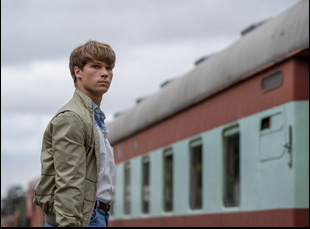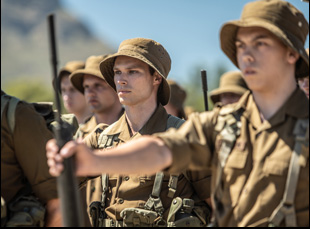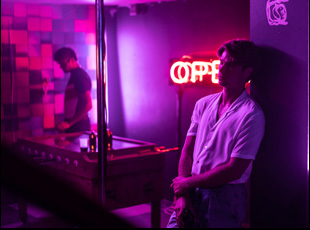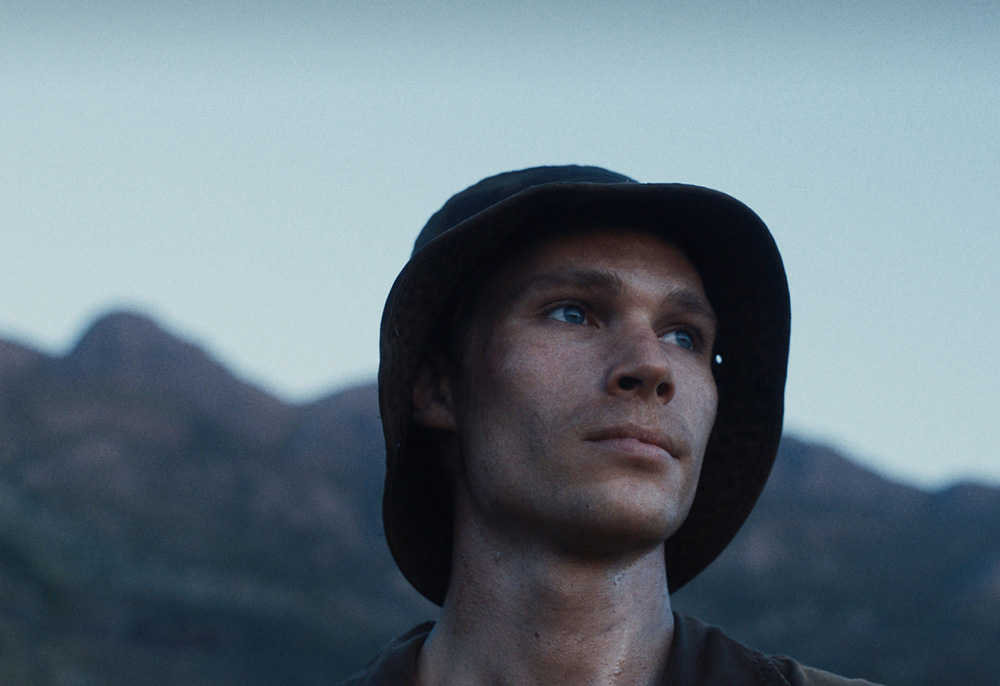When any of the young actors that Oliver Hermanus enlisted to play soldiers in the South African National Defence Force for “Moffie” asked the director where they might look for researching their parts beyond what was in the script for his adaptation of André Carl van der Merwe’s memoir, he had some simple advice for them — call their father.
“Although I don’t think they had never spoken to their fathers about it until they made this film, it was a connection,” says Hermanus, knowing that to grow up white in South Africa during apartheid meant mandatory service in the military. “I was fascinated by that [because] we were making a film that was foreign to me. I’m not white, so my father didn’t go into that military and he was not subject to conscription, so I was really the furthest away from it, but having these young actors who were younger than me, all born post-apartheid, for them to have such a direct line to that time because it’s the story of their fathers was quite potent. It was a way to bringing me into the film, which is knowing it’s not a film about long, long ago. It’s actually a present part of South African society and history.”
One feels that inescapable grasp as much as Nicholas van der Swart (Kai Luke Brummer) in “Moffie” when he’s pulled into the army, uncomfortable with fighting for a cause he doesn’t necessarily believe in — or the entire notion of combat, for that matter — but made more so when soldiers are toughened up by their superiors with constant attacks on their masculinity. While Nicholas is surrounded by men eager to prove themselves, he is questioning his sexuality amidst rumors of those who fall out of line being sent to a mysterious Ward 22 to receive conversion therapy. His sense of isolation is conveyed through framing that feels as if it’s growing ever tighter around him, though “Moffie” also quite literally brings out the silver linings in its vibrant color palette of having to be confronted time and again with an attraction to the same sex when there’s nary a woman in sight, as Nicholas’ overall confidence in himself improves with every hard-won epiphany he has in understanding who he is.
After premiering at Venice in the fall of 2019, “Moffie” could be expected to be a breakout for Hermanus and its star Brummer, but its festival run was largely cut short by the coronavirus, leaving it for audiences to discover now as it starts to resurface in general release. Finally hitting American shores this week, the director spoke about the film’s distinctive style, how he drew from his own experience and putting his actors through a real-life boot camp.

In the beginning, it was what didn’t get me interested in it? I read it and was unsure of it and then at some point, I thought well, you know, I need to find my way into this. I did by adapting it in a way that felt more personal and it became the film that it is now.
What unlocked it for you?
I wanted to have a central moment in the film that gets to the heart of the matter, and that’s a scene that I pulled from my own life, not to that extremity, but launched out of my own experience. I love that about making films – it needs to register with me on some level and even in the film I’m currently preparing [now] here in London, [about] an aged man who’s at the end of his life facing death, I have to still find something in it that connects with me. That’s the journey that I like to go on as a filmmaker.
You’re referring to a flashback in the film, which I wouldn’t want to spoil, but comes at a really interesting time in the film and is the only scene of its kind. Was it always there?
It was always there – that was the moment where it’s set, and it was always meant to be at the midway point in the story, [because] at the moment of his great sexual awakening, there would be this immediate return to his great sexual represssion. That’s how I thought about it — the moment of his innocence being lost in a way that comes after the moment of his adult liberation.

Yeah, to see what the world looked like at the time, thanks to the internet, a lot of people had uploaded their personal memories and scans of printouts onto the internet and different Facebook groups, so I started seeing all of these personal memories. Seeing the effect of desaturation and the colors and the nature of those cameras and the stock that they were using, which was obviously Kodak, it just felt like this is how we remember this time. This is the look and feel of it and the DOP and I thought it would be great to emulate that in how we treated the form.
I understand you might’ve had a mild disagreement with your DOP about the aspect ratio, which is really unusual. How did you get to where you did?
Yeah, there’s something lovely about the aspect ratio, which we both fell in love with more as we were making the film. The nature of that frame lends itself to portraiture. The way that you place people in the frame and how you shoot faces is very particular, so it just created a sense of intimacy that I don’t think we would’ve had if we had shot in Cinemascope, which is what he wanted to do initially because he just thought it would be better for landscape if we were wider. I thought it would be better for people if we were narrower, and thankfully I’m the director, so I always get to win in those debates. [laughs]
You’ve got a number of scenes where you’re filming 360° – are those difficult to stage?
It’s always interesting when you have many moving parts on a set when you’ve got many characters in the same frame. It does become like corralling livestock and one of our hardest things to do is when you’ve got explosions going off and stunts and many, many actors running around shooting guns, those become the difficult scenes because you worry about the actors using real guns and you’re very worried about bombs going off around them. Then you’re doing it at night, so those were the scenes where I really had to have my wits about me because there’s lots of things going on. Thankfully, this movie is about the military, so we could approach it from a militant perspective where we would just treat [the actors] like they were in the army and get them into formation and move them around. And what I liked about our aspect ratio is it really forced us to either be very, very far away or very, very close because you could never get scale unless you were very far away, so I think we very naturally fell into it. By the end of it, we just vowed to make everything going forward in the same aspect ratio, but I’m not sure that we will. I think each film has to have its own intuitive photographic instinct about it.

The boot camp was very helpful to all of us, particularly the actors because it bonded them and I had a sense of the unforgiving hardship of that experience. Our military adviser was very prepared to give them the real experience. He was incredibly committed to terrorizing them and they loved him and hated him for it.
What sold you on Kai to play this guy?
We had seen Kai many times. He had come in for casting for different characters and we were sold on him after seeing him on stage in the play “The Curious Case of the Dog in the Nighttime.” It’s a very demanding performance, and I was just quite convinced by the depth of his performance [which] gave me great confidence. I think was worth it and worked for Moffie as well.
What’s it been like getting this out into the world?
We had a good six months before the pandemic locked us up where I was traveling with “Moffie,” so I at least got a little bit of the interaction with the audience and I think this is definitely the longest journey I’ve had with a film — I feel like “Moffie” has become a major part of my adult life because it’s been almost six years since I first read the book, and it identified me to a different group of people in the film industry, so the movie has given me a lot of new opportunities, and it’s also given a lot of opportunities to many of us – the photographer, many of the actors, they’re all doing very interesting and exciting things internationally at the moment, so the film has been wonderful to all of us.
“Moffie” opens in select theaters and on VOD on April 9th.




